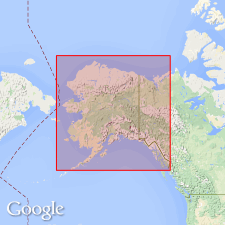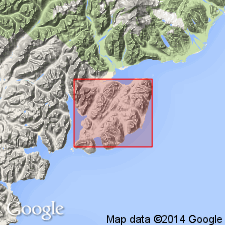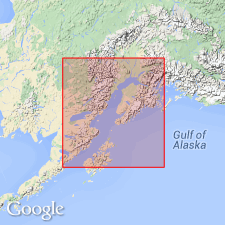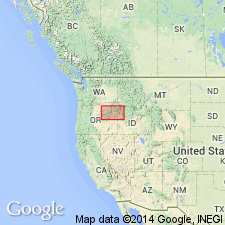
- Usage in publication:
-
- Tonnie sandstone member
- Modifications:
-
- First used
- Dominant lithology:
-
- Sandstone
- Shale
- Conglomerate
- AAPG geologic province:
-
- Alaska Southwestern region
Summary:
Composite table lists Tonnie sandstone member as uppermost member of Tuxedni formation of Iniskin Chinitna Peninsula area, southwestern AK. Consists of series of alternating sandstones, shales, and coarse conglomerate with numerous fossil bearing horizons. Is 1200 ft thick. Overlies unnamed sandy shale member of Tuxedni formation. Underlies Chinitna shale. Age given as Late Jurassic.
Source: GNU records (USGS DDS-6; Menlo GNULEX).

- Usage in publication:
-
- Tonnie siltstone member*
- Modifications:
-
- Named
- Dominant lithology:
-
- Siltstone
- Sandstone
- AAPG geologic province:
-
- Alaska Southwestern region
Summary:
Named as youngest named member (of 3) of Tuxedni formation [probably for exposures in vicinity of Tonnie Peak] where unit is best exposed. Crops out in trough of Tonnie syncline and in long, narrow belt that extends from Chinitna Bay to Iniskin Bay along west face of coastal ridge on Iniskin Peninsula. Consists of 900 ft of siltstone capped by 200 ft of sandstone. Siltstone is dark gray, weathering to light brown, calcareous in part. Resistant sandstone is cliff-forming. Overlies Bowser member (new) of Tuxedni formation. Underlies Chinitna siltstone. East of Bowser Creek, sandstone beds unit contains fauna similar to fauna in upper part of Bowser member. Age is considered Middle Jurassic and possibly Late(?) Jurassic.
Source: GNU records (USGS DDS-6; Menlo GNULEX).

- Usage in publication:
-
- Tonnie siltstone member*
- Modifications:
-
- Revised
- AAPG geologic province:
-
- Alaska Southwestern region
Summary:
Rocks of Tonnie siltstone member of Tuxedni formation of Kirschner and Minard (1948) are reassigned to Chinitna formation since sandstone capping of Tonnie disappears to south, and in most places siltstones cannot be separated from overlying siltstones of Chinitna. Forms roughly lower third of Chinitna formation. Age of ammonite fossils in unit is Callovian.
Source: GNU records (USGS DDS-6; Menlo GNULEX).

- Usage in publication:
-
- Tonnie Siltstone Member*
- Modifications:
-
- Age modified
- AAPG geologic province:
-
- Alaska Southwestern region
Summary:
Correlation chart shows age of Tonnie Siltstone Member of Chinitna Formation is late Bathonian(?) and early Callovian age (Middle Jurassic). Underlies Paveloff Siltstone Member of Chinitna Formation. Unconformably overlies Bowser Formation.
Source: GNU records (USGS DDS-6; Menlo GNULEX).
For more information, please contact Nancy Stamm, Geologic Names Committee Secretary.
Asterisk (*) indicates published by U.S. Geological Survey authors.
"No current usage" (†) implies that a name has been abandoned or has fallen into disuse. Former usage and, if known, replacement name given in parentheses ( ).
Slash (/) indicates name conflicts with nomenclatural guidelines (CSN, 1933; ACSN, 1961, 1970; NACSN, 1983, 2005, 2021). May be explained within brackets ([ ]).

